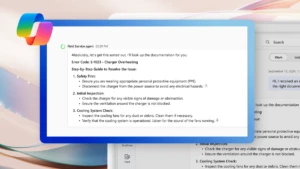Announcing Power Platform and Dynamics 365 Updates for Microsoft Government Cloud
In the government world, I hear from civic leaders and IT staff who understand how the cloud and modern data technologies could improve efficiency and the citizen experience of government. These government leaders and staff know their technology challenges better than anyone else: governments often have legacy systems, staff struggle to make changes to customer solutions without IT help, there are complex IT structures, strict compliance regulations, and siloed data that make it difficult for leaders and staff to work data in a transformative way to drive their missions.
Microsoft is committed to enabling government agencies to reduce the complexity of IT, meet compliance and security regulations, and turn data and insight into intelligent action – making interactions with citizens impactful and driving government efficiencies.
Today, we’re excited to announce updates to the Power Platform and Dynamics 365 in the Microsoft Government Cloud.
Power Platform in the Microsoft Government Cloud
Agencies are adopting the cloud to store data from a multitude of sources like web traffic and business systems. Once an organization has the infrastructure for harnessing data, they also need a layer atop that data that enables them to get insights easily. That’s what the Power Platform is—a system that enables users to do three key actions on data: Analyze, Act, and Automate. Power BI, PowerApps, and Flow work together to help anyone, regardless of technical ability, drive decisions with data.
As of March 2019, standalone PowerApps and Microsoft Flow for Government is generally available. PowerApps and Flow general availability will also land in Dynamics 365, Microsoft 365 and Office 365 in spring 2019. This environment will support compliance with US government requirements for cloud services, including FedRAMP High, and requirements for criminal justice.
PowerApps is a low-code/no-code app development platform, allowing anyone to build web and mobile applications without writing code. Often, agencies will find the application they need in the ready-to-use applications available in Dynamics 365. But if an agency has custom needs, PowerApps is a great way to quickly develop applications that work seamlessly with the rest of the Microsoft Government Cloud, reducing siloes, allowing innovation across teams, and making maintenance for IT much simpler.
Microsoft Flow is an intelligent process automation service that goes beyond simple task automation, allowing non-technical users to automate complex business processes and workflows without a complex IT deployment.
Power BI is a self-service business intelligence solution that makes it easy to connect, analyze and gain insight from the data with dashboards and reports, wherever that data resides. Power BI for Government is currently available.
Imagine a disaster response with responders in the field. With the Power Platform, field staff can use a PowerApps on their phones to take photos of damage, record notes, and request supplies. Microsoft Flow can automatically create a ticket that staff in supply and logistics can review and fulfill. With Power BI, managers can monitor progress and costs with customizable dashboards, reports, and maps. The Power Platform provides a system that continuously populates with data, enabling responders and managers to react effectively and quickly.
For a deeper look at the Power Platform, read this recent blog by James Phillips, Corporate Vice President of the Business Applications Group: The Microsoft Power Platform – Empowering millions of people to achieve more.
Dynamics 365 Customer Engagement in the Microsoft Government Cloud
In April, Microsoft will introduce additional Dynamics 365 Customer Engagement services to support the requirements of the DoD for contractors holding, or processing DoD controlled unclassified information or subject to International Traffic in Arms Regulations (ITAR). The Dynamics 365 Government services will provide support for the DoD Cloud Computing Security Requirements Guide for information up to Impact Level 4.
Securing high-impact level data – defined as data that, if leaked or improperly protected, could have a severe adverse effect on organizational operations, assets, or individuals – is a priority for Microsoft. Organizations can now take advantage of Dynamics 365 Customer Engagement Government not only for applications that use low and moderate impact data, but also those that use sensitive high impact data. In other words, government organizations can accelerate their digital transformation by using Dynamics 365 Customer Engagement Government for customer service, contact centers, correspondence management, grants management, task management, mission planning and even more purpose-built cloud applications than they were able to previously.
For example, with Dynamics 365 for Field Service, government organizations can innovate with proactive services and deliver a seamless, end-to-end service experience for customers. Built-in intelligence helps you resolve service issues before they occur, reducing operational costs, and deliver positive onsite experiences. Three core areas that drive efficiency are Preventative Maintenance, Scheduling & Dispatch, and Technician Productivity.
Also, with Dynamics 365 for Customer Service government organizations can deliver effortless customer experiences on their terms, enable employees to meet rising customer expectations and stay agile to drive innovation with an application that is easy to tailor, extend, and connect.
Today’s updates for the Microsoft Power Platform enable government customers, and Dynamics 365 updates enable government customers and DoD contractors to unlock new capabilities and features in three core areas: new business applications; new intelligent capabilities infused throughout; and transformational new application platform capabilities.
Visit the Microsoft Power Platform Trust Center and Dynamics 365 Trust Center for additional background, and to see the latest in Microsoft Business Applications innovation take a look at our April 2019 Release Notes.




